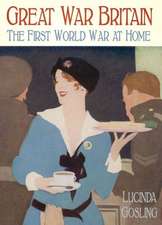Enforcing the English Reformation in Ireland: Clerical Resistance and Political Conflict in the Diocese of Dublin, 1534–1590: Cambridge Studies in Early Modern British History
Autor James Murrayen Limba Engleză Paperback – 20 iul 2011
| Toate formatele și edițiile | Preț | Express |
|---|---|---|
| Paperback (1) | 365.22 lei 6-8 săpt. | |
| Cambridge University Press – 20 iul 2011 | 365.22 lei 6-8 săpt. | |
| Hardback (1) | 759.18 lei 6-8 săpt. | |
| Cambridge University Press – 11 feb 2009 | 759.18 lei 6-8 săpt. |
Din seria Cambridge Studies in Early Modern British History
-
 Preț: 195.92 lei
Preț: 195.92 lei - 8%
 Preț: 530.93 lei
Preț: 530.93 lei - 11%
 Preț: 693.36 lei
Preț: 693.36 lei -
 Preț: 317.75 lei
Preț: 317.75 lei -
 Preț: 240.74 lei
Preț: 240.74 lei - 8%
 Preț: 530.27 lei
Preț: 530.27 lei - 9%
 Preț: 627.56 lei
Preț: 627.56 lei -
 Preț: 350.34 lei
Preț: 350.34 lei - 14%
 Preț: 919.83 lei
Preț: 919.83 lei -
 Preț: 422.86 lei
Preț: 422.86 lei -
 Preț: 419.37 lei
Preț: 419.37 lei -
 Preț: 314.10 lei
Preț: 314.10 lei -
 Preț: 441.96 lei
Preț: 441.96 lei -
 Preț: 366.58 lei
Preț: 366.58 lei - 11%
 Preț: 695.39 lei
Preț: 695.39 lei -
 Preț: 278.34 lei
Preț: 278.34 lei -
 Preț: 426.88 lei
Preț: 426.88 lei - 14%
 Preț: 919.33 lei
Preț: 919.33 lei - 14%
 Preț: 773.45 lei
Preț: 773.45 lei -
 Preț: 211.02 lei
Preț: 211.02 lei -
 Preț: 334.35 lei
Preț: 334.35 lei - 14%
 Preț: 828.64 lei
Preț: 828.64 lei -
 Preț: 356.88 lei
Preț: 356.88 lei -
 Preț: 446.58 lei
Preț: 446.58 lei - 14%
 Preț: 830.20 lei
Preț: 830.20 lei -
 Preț: 284.39 lei
Preț: 284.39 lei - 14%
 Preț: 867.49 lei
Preț: 867.49 lei - 14%
 Preț: 1223.82 lei
Preț: 1223.82 lei - 14%
 Preț: 963.64 lei
Preț: 963.64 lei -
 Preț: 336.20 lei
Preț: 336.20 lei -
 Preț: 445.81 lei
Preț: 445.81 lei -
 Preț: 274.11 lei
Preț: 274.11 lei -
 Preț: 362.54 lei
Preț: 362.54 lei - 14%
 Preț: 923.48 lei
Preț: 923.48 lei -
 Preț: 275.08 lei
Preț: 275.08 lei - 14%
 Preț: 733.64 lei
Preț: 733.64 lei -
 Preț: 276.39 lei
Preț: 276.39 lei -
 Preț: 336.48 lei
Preț: 336.48 lei -
 Preț: 408.81 lei
Preț: 408.81 lei -
 Preț: 309.27 lei
Preț: 309.27 lei -
 Preț: 369.67 lei
Preț: 369.67 lei -
 Preț: 274.27 lei
Preț: 274.27 lei - 14%
 Preț: 778.74 lei
Preț: 778.74 lei
Preț: 365.22 lei
Nou
Puncte Express: 548
Preț estimativ în valută:
69.90€ • 72.69$ • 58.49£
69.90€ • 72.69$ • 58.49£
Carte tipărită la comandă
Livrare economică 15-29 martie
Preluare comenzi: 021 569.72.76
Specificații
ISBN-13: 9780521369947
ISBN-10: 0521369940
Pagini: 376
Dimensiuni: 152 x 229 x 20 mm
Greutate: 0.5 kg
Editura: Cambridge University Press
Colecția Cambridge University Press
Seria Cambridge Studies in Early Modern British History
Locul publicării:Cambridge, United Kingdom
ISBN-10: 0521369940
Pagini: 376
Dimensiuni: 152 x 229 x 20 mm
Greutate: 0.5 kg
Editura: Cambridge University Press
Colecția Cambridge University Press
Seria Cambridge Studies in Early Modern British History
Locul publicării:Cambridge, United Kingdom
Cuprins
Introduction; 1. 'Handmaid' of the English church: the diocese of Dublin on the eve of the Reformation; 2. 'Faithful Catholics of the English nation': patriotism, canon law and the corporate clergy; 3. Rebellion and supremacy: Archbishop Browne, clerical opposition and the enforcement of the early Reformation, 1534–40; 4. 'God's laws and ours together': Archbishop Browne, political reform and the emergence of a new religious settlement, 1540–2; 5. The rise and fall of the Viceroy's settlement: property, canon law and politics during the St Leger era, 1542–53; 6. Archbishop Dowdall and the restoration of Catholicism in Dublin, 1553–5; 7. Rejuvenation and survival: the old religion during the episcopacy of Hugh Curwen, 1555–67; 8. Archbishop Loftus and the drive to protestantise Dublin, 1567–90; Afterword; Appendix I. The division of administrative responsibilities between the two Dublin cathedrals; Appendix II. The parishes of the diocese of Dublin, 1530–1600.
Recenzii
Review of the hardback: '… Murray's work … provides a modern analysis of the physical makeup of the Tudor diocese of Dublin and also illuminates the careers of the individuals who headed that diocese following Henry VIII's split with Rome. Furthermore it supplies one of the most succinct accounts yet written of how the religious changes enacted by the Tudors impacted upon the wider public life of Dublin and the Irish kingdom. As such it makes an important advance in our understanding of many aspects of the Tudor Reformations in Ireland and contributes significantly to the debate thereon.' David Heffernan, Oenach
'… this much anticipated volume has a great deal that is new and important to say on the subject [of why the Reformation failed in Ireland] … the author's fresh perspective on an old problem marks this as a Reformation study of high quality.' Irish Economic and Social History
'… this much anticipated volume has a great deal that is new and important to say on the subject [of why the Reformation failed in Ireland] … the author's fresh perspective on an old problem marks this as a Reformation study of high quality.' Irish Economic and Social History
Descriere
This text examines the efforts of the Tudor regime to implement the English Reformation in Ireland during the sixteenth century.




















